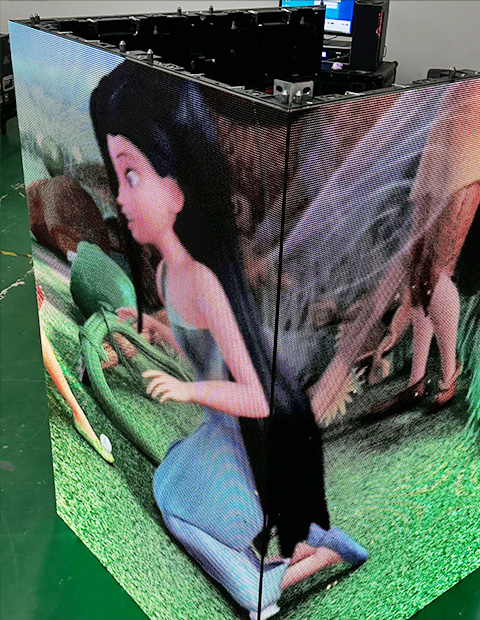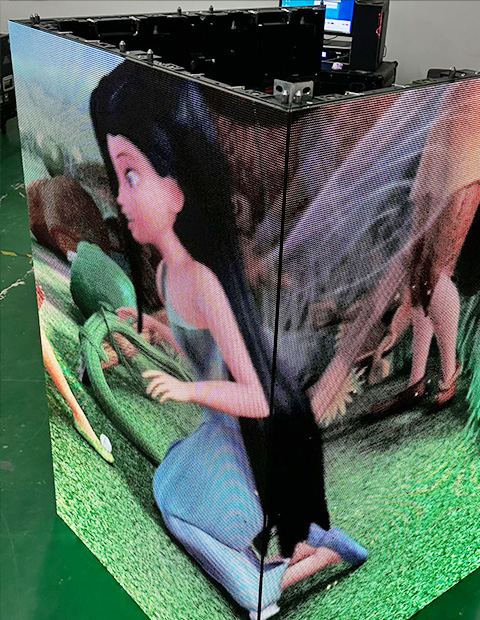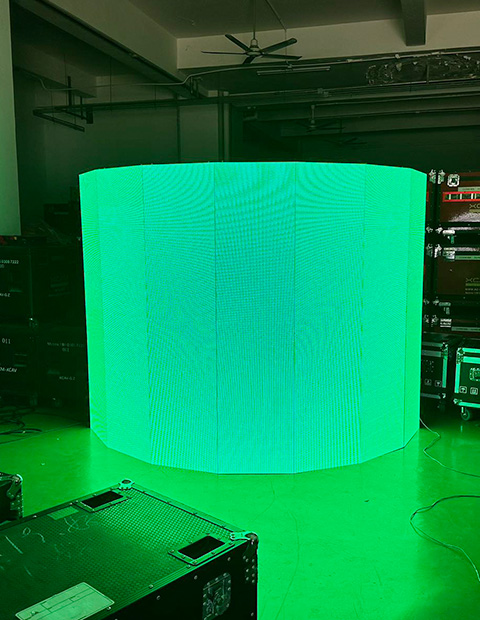Introduction
As electronic LED screens become increasingly used in our daily lives, high-definition LED displays are now ubiquitous. However, some LED screens may exhibit visible artifacts such as stripes or a lack of image detail when viewed or recorded with high-definition cameras. These issues are often linked to the grayscale levels and refresh rates of LED screens. In this blog, we will explore the details.
What are the Gray Scale Levels of LED Displays?
Gray scale levels refer to the variation in different shades of colors between peak darkness and peak brightness on an LED screen. Traditional high-definition LED displays typically have grayscale levels ranging from 14 bits to 16 bits, offering over 16,000 shades of color. This wide range of shades enables the display to reveal intricate color details. When gray scale levels are insufficient, the color hierarchy may appear inadequate, and the transition between colors may not be smooth, resulting in an incomplete representation of the displayed images.
Insufficient gray scale levels significantly compromise the overall display quality of an LED screen. If you capture an image with a shutter speed of 1/500 seconds and notice pronounced color blocks, it indicates that the screen has low gray scale levels. Using even higher shutter speeds, such as 1/1000 seconds or 1/2000 seconds, will result in more conspicuous color blocks, severely affecting the overall visual appeal of the content.
What is the Refresh Rate of LED Displays?
Refresh rate, measured in Hertz (Hz), indicates how quickly the screen updates its content. Traditional LED screens commonly have refresh rates ranging from 720Hz to 1920Hz, while small-pitch LED displays have refresh rates between 3000Hz and 3840Hz, or even higher. A higher refresh rate leads to a sharper and more stable image, with reduced video flicker. In general, for regular high-definition LED displays, a refresh rate of around 1920Hz is enough for most users unless they are viewing from a very close distance.
However, for applications like live broadcasts, stage performances, and large events where close-up viewing is common, a refresh rate of 3840Hz or higher is required to meet the demands for high-definition image quality. A lower refresh rate can lead to visible horizontal stripes in captured images, as well as flickering, and may even cause visual fatigue for viewers over extended periods.

Relationship between Refresh Rate and Gray Scale Levels
The refresh rate and gray scale levels of a high-definition LED screen are closely related to the LED driver chips used. The higher the refresh and grayscale levels of the driver chip, the higher the LED screen’s overall refresh rate and grayscale. To achieve this, many used LED display suppliers, including GDHANHENG, use Scrambled Pulse Width Modulation (S-PWM) technology.
S-PWM technology improves upon traditional Pulse Width Modulation (PWM) by breaking down the time each pixel is on (LED pixel on) into several shorter durations. This effectively increases the overall visual refresh rate or refresh frequency, as the screen’s on/off state is updated more frequently.
Next-generation LED driver chips often come with integrated S-PWM technology, allowing the LED screen to update multiple times within a single frame without compromising performance or stability. S-PWM technology provides different counting modes, allowing it to improve the refresh rate significantly. By switching from a regular driver IC to one with S-PWM technology, you can effectively increase the LED screen’s refresh rate, sometimes by up to 64 times. This results in a refresh rate exceeding 4800Hz.
In addition to the visual benefits, S-PWM technology also helps avoid issues like high-frequency electromagnetic interference, overvoltage transients, and under-voltage transients. With the use of S-PWM-driven chips, the refresh rate and gray scale levels are significantly higher than those achievable with standard switching-type driver chips.
The use of S-PWM-driven chips enables high-definition LED displays to achieve refresh rates of 4800Hz or more. This means that when recording with high-definition cameras, issues like horizontal black scan lines and color block distribution can be eliminated. Whether it’s the refresh rate or grayscale levels, both surpass what can be achieved with regular switching-type driver chips. As a result, small-pitch LED display manufacturers particularly those used in applications like stage performances and live events, prioritize S-PWM-driven chips to elevate refresh rates and grayscale levels.
What are the driver chips of LED Displays?
LED driver chips, also known as LED display driver ICs (Integrated Circuits), are essential components in LED displays. These chips are responsible for controlling the individual LEDs (Light Emitting Diodes) on the display to produce the desired images and colors. They play a critical role in managing the power, data, and timing required to create a display that can show text, graphics, and videos.
What are the Common LED display driver chips?
Here are some common LED display driver chips.
TLC5941 driver chip
The TLC5941 chip is the product launched by TI (Texas Instruments) and has features such as point correction and high grayscale (PWM control). All internal data registers, grayscale registers, point correction registers, and error status information.
The maximum serial clock frequency is 30 MHz. The inter-chip current error is generally within ±6%, and the inter-bit current error is generally within ±4%; the maximum output current per channel is 80 mA. Each channel of the TLC5941 can perform 4,096 levels of grayscale control based on the value of the internal grayscale register in PWM mode. The register is 12 bits.
The LED drive circuit of each channel is controlled by the value of the 6-bit point correction register for 64 levels. The maximum value of the drive current can be set through an off-chip resistor. The 64-level current control allows LED point grayscale correction, and the 4,096-level grayscale adjustment ensures that even at lower grayscale levels, each point in the dot matrix has up to 256 levels of grayscale representation.
Therefore, the red, green, and blue full-color LED screen can have the color expression capability of 16M colors. These two points are particularly important for high-quality color large-screen LED displays.
Compared with the traditional color large LED display system, which centrally generates PWM for grayscale control, the programmable logic chip (or high-speed CPU) only needs to process cache management, the output of grayscale and point correction data, the design complexity is reduced. Due to the PWM, the grayscale control has nothing to do with data serial migration, which can easily archive higher frame rates and achieve good dynamic display effects.
In order to ensure the reliable operation of the large colorful LED screen, TLC5941 provides each LED open circuit (LOD) and over-temperature detection (TSD) capabilities, and has a built-in open collector output circuit to alarm when an error occurs. No matter which channel among the 16 channels has an error, the output pin of the built-in open collector output circuit will be pulled to a low level.
By querying the internal status information of the chip, you can know which channel has failed. All TLC5941s in the system The output pins of the built-in open collector output circuit can be connected together and connected to a high level through a pull-up resistor. By monitoring this signal, the system can perform self-diagnosis during operation. TLC5941 is suitable for applications where the working environment is harsh and high requirements for display effects and safety performance are required, such as LED information signs on highways, large outdoor LED TVs, etc.
MBI5028 driver chip
MBI5028 is an LED screen driver chip with programmable current gain function launched by Taiwan MBI (Macroblock Technology). It has built-in serial and parallel shift registers and output latches, and uses PrecisionDrive technology to archive better electrical characteristics. The maximum serial clock frequency of MBl5028 is 25 MHz, the inter-chip current error is generally within ±6%, the inter-bit current error is generally within ±3%, and the maximum output current is 90 mA.
MBI5028 has a built-in current gain control logic unit. The programmable current gain function adopts Share-IO technology. There is no need to add additional pins. You only need to input a specific sequence signal on the corresponding pin to enter the special function mode of MBI5028 – -Current adjustment mode.
In this mode, the system microcontroller can write data of different current gains to the current gain control logic unit, latch the data, and effectively control the current output through the built-in converter shared between digital and analog. Due to changes in the working environment and aging of the LED screen, the brightness will decrease.
If a fixed forward current is used, the brightness deviation of the LED screen will be smaller. Through the programmable current gain function and PrecisionDrive technology, the current deviation can be adjusted to compensate for the brightness of the LED screen while getting a relatively high-quality image. Utilizing PrecisionDrive technology and built-in digital and analog shared converters, with the same accuracy, by changing the digital code, the relative output current is obtained, thereby improving the imaging quality of the LED screen.
They can provide 256 current levels to an LED display, allowing it to reach 1,200% of the total dynamic range and provide 256 output current levels in terms of electrical characteristics and chip packaging. Due to the MBI5026 has relatively good compatibility, Users can get current gain technology with Share-IO technology without changing the PCB board previously designed for the same type of chip, which can greatly reduce upgrade costs.
MBI5026 is suitable for applications that do not have harsh working environments but require high-quality imaging, such as medium and low-end LED screens such as large indoor LED displays. At the same time, MBI5028 is also suitable for upgrading old driver chips.
ST2221C driver chip
ST2221C is an LED screen driver chip launched by SITI (Silicon Technology) Company in Taiwan, China. It has built-in serial and parallel shift register units, output latch units, and current output control units and has excellent electrical characteristics. The maximum serial clock frequency of ST2221C is 25 MHz, the inter-chip current error is generally within ±10%, the inter-bit current error is generally within ±6%, and the maximum output current is 120 mA.
ST2221C contains a 16-channel constant current driver unit and can drive 16 LEDs simultaneously. It is suitable for driving some low-end screens, such as indoor information screens and other low-end LED displays.
Conclusion
The grayscale levels and refresh rates of LED displays are important factors that significantly impact the viewing experience and the quality of recorded content. Higher gray scale levels enable the LED screen to display a wider range of colors and subtle details, while a higher refresh rate ensures a smoother and more stable visual experience. These factors are closely related to the LED driver chips used, with S-PWM technology playing a crucial role in achieving superior performance.
To ensure the best performance and image quality, you can consider choosing the high gray scale levels and refresh rates of LED screens, especially for applications where close-up viewing and high-definition recording are essential. As technology advances, LED displays are likely to become even more impressive, delivering stunning visuals with remarkable clarity and precision.



